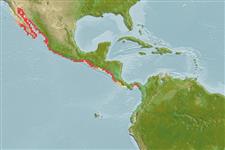Actinopterygii (ray-finned fishes) >
Ophidiiformes (Cusk eels) >
Ophidiidae (Cusk-eels) > Ophidiinae
Etymology: Ophidion: Diminutive of Greek, ophis = serpent (Ref. 45335).
Environment / Climate / Range
Ecology
Marine; demersal; depth range 17 - 75 m (Ref. 34024). Tropical, preferred ?; 32°N - 8°N
Eastern Central Pacific: outer coast of Baja California and northern Gulf of California to the Gulf of Panama.
Size / Weight / Age
Maturity: Lm ? range ? - ? cm
Max length : 21.5 cm SL male/unsexed; (Ref. 9329); common length : 12.0 cm TL male/unsexed; (Ref. 55763)
Uncommon species found from near shore to 75 m depth (Ref. 34024). Inhabit bottoms with fine sand, mud, rubble or marine plants, at moderate depths (Ref. 9329). Oviparous, with oval pelagic eggs floating in a gelatinous mass (Ref. 205). Frequently caught by shrimp trawlers (Ref. 9329). Minimum depth from Ref. 58018.
Life cycle and mating behavior
Maturity | Reproduction | Spawning | Eggs | Fecundity | Larvae
Nielsen, J.G., D.M. Cohen, D.F. Markle and C.R. Robins, 1999. Ophidiiform fishes of the world (Order Ophidiiformes). An annotated and illustrated catalogue of pearlfishes, cusk-eels, brotulas and other ophidiiform fishes known to date. FAO Fish. Synop. 125(18):178p. Rome: FAO. (Ref. 34024)
IUCN Red List Status (Ref. 115185)
CITES (Ref. 94142)
Not Evaluated
Threat to humans
Harmless
Human uses
More information
Age/Size
Growth
Length-weight
Length-length
Length-frequencies
Morphometrics
Morphology
Larvae
Larval dynamics
Recruitment
Abundance
ReferencesAquacultureAquaculture profileStrainsGeneticsAllele frequenciesHeritabilityDiseasesProcessingMass conversion
Tools
Special reports
Download XML
Internet sources
Estimates of some properties based on models
Phylogenetic diversity index (Ref.
82805): PD
50 = 0.5000 [Uniqueness, from 0.5 = low to 2.0 = high].
Bayesian length-weight: a=0.00275 (0.00131 - 0.00577), b=3.17 (2.99 - 3.35), in cm Total Length, based on LWR estimates for this (Sub)family-body shape (Ref.
93245).
Trophic Level (Ref.
69278): 3.6 ±0.7 se; Based on size and trophs of closest relatives
Resilience (Ref.
69278): High, minimum population doubling time less than 15 months (Preliminary K or Fecundity.).
Vulnerability (Ref.
59153): Low to moderate vulnerability (27 of 100) .
